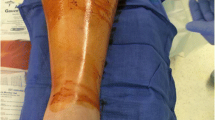Abstract
Surgical treatment of proximal tibial fractures requires open reduction and internal fixation. The operative exposure causes additional soft-tissue injury and reduces the blood supply to the bone. A cephalograde tibial nail should offer comparable mechanical stability without these disadvantages. We compared the stability of both osteosyntheses in a fracture model with 12 fresh-frozen cadaver bones. While both implants exhibited comparable stiffness under sagittal loading, the plate had a higher rotational and varus stiffness. Despite this higher stiffness, rotational displacements at the fracture gap were nearly twice as large for this implant during loading. We conclude that the retrograde nail provides similar mechanical stability to plate fixation for proximal tibial fractures, while the closed reduction and soft-tissue preservation of this new technique are definite advantages.
Similar content being viewed by others
Author information
Authors and Affiliations
Additional information
Received: 28 July 1998
Rights and permissions
About this article
Cite this article
Pommer, A., Wieser, A., Hahn, M. et al. Fixation of proximal tibia fractures by a retrograde nail: a biomechanical investigation. Arch Orth Traum Surg 120, 212–214 (2000). https://doi.org/10.1007/s004020050047
Issue Date:
DOI: https://doi.org/10.1007/s004020050047




